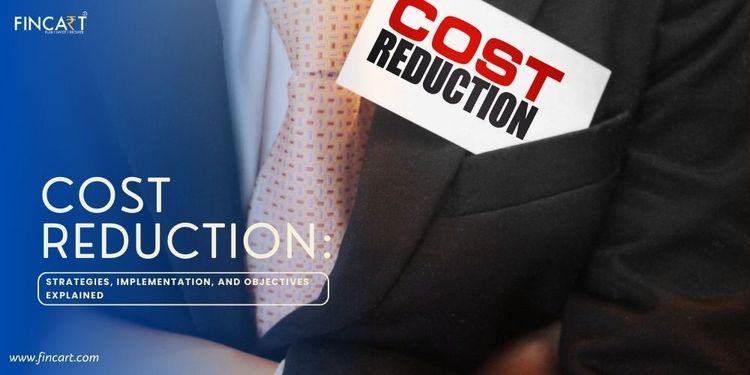Table of Contents
ToggleDo you want to lower your business costs without compromising quality or productivity? Do you want to increase your profits and grow your market share? If yes, then you need a cost reduction strategy. Don’t let your expenses eat up your profits. In this article, you will learn how to slash the bad costs and boost the good ones with an efficient cost-reduction strategy.
Let’s start with the fundamentals.
What is a cost reduction strategy?
A cost-cutting strategy is a plan to reduce expenses that do not add value to your business while investing in those that do. You can improve operational efficiency, increase competitive advantage, and achieve strategic goals by cutting costs.
Let us better understand this by using a relatable real-life example.
Assume you own a business and want to implement an effective cost-cutting strategy by encouraging remote working. With remote working, you can increase productivity and flexibility, which can lead to cost reductions and increased employee satisfaction.
Additionally, seeking financial advice from experts in business optimization can provide valuable insights and guidance on implementing a successful cost-cutting strategy tailored to your specific business needs.
Why employ a cost reduction strategy?
With the right cost reduction strategy on the spot, you can reduce your ongoing costs while increasing your profits without having to raise your prices. You can increase operational efficiency, build up sales and market share, and eliminate any activities or products that are not consistent with your vision, mission, and values.
However, a cost reduction strategy may also expose you to different types of credit risk: the risk of loss due to a borrower’s failure to repay a loan or meet a contractual obligation.
Top 10 Cost Reduction Strategies For Your Business
When deciding the best cost reduction strategy for your business, no one-size-fits-all. It varies from business to business depending on your nature of business, the market, and the competitors.
Let us discuss in detail, the top 10 time-proven cost reduction strategies for your business-
1. Embrace remote working:
Remote working can facilitate cost reductions in the shape of office rent, utilities, equipment, and travel. You can also tap into a broader pool of talent and boost employee performance and loyalty.
Remote working may present some difficulties in employee induction, motivation, and communication, but they can be solved with appropriate systems and tools.
2. Improve your supplier negotiations:
Suppliers are often willing to offer lower prices or better terms to loyal and dependable customers. You can bargain with your suppliers to get lower prices on raw materials, services, and delivery. Long-term relationships, bulk orders, and favorable payment terms can also be used to obtain better deals. You should maintain the quality of the materials or services you receive.
3. Outsource non-essential processes:
Outsourcing non-core functions such as accounting, marketing, or IT can help you reduce labor costs and overhead. You can also benefit from the outsourced providers’ expertise and efficiency. However, you should exercise caution when selecting providers meeting your quality standards and expectations.
4. Streamline routine tasks:
Streamlining tasks that are tedious, manual, or error-prone can help you save time, money, and resources. You can use software tools, bots, or artificial intelligence to streamline tasks such as data entry, invoicing, customer service, or reporting.
5. Adopt cloud-based solutions:
Cloud-based solutions can help you lower IT costs and enhance scalability and security. You can use cloud-based software, storage, or platforms to access applications and data from any location and time. However, you should ensure that the cloud-based solutions are dependable and compatible with your existing systems.
6. Lower energy consumption:
Lowering energy consumption can help you reduce your utility bills and environmental impact. You can use energy-efficient appliances, lighting, and heating systems, as well as implement energy-saving practices such as turning off unused devices or adjusting thermostats. However, you should ensure that the energy reduction does not affect your productivity or comfort.
7. Implement a cost reduction strategy for inventory management:
Implementing a cost reduction strategy for inventory management can help you lower storage costs and avoid overstocking or understocking.
You can use inventory management software or techniques such as just-in-time or lean manufacturing to track and control your inventory levels and demand. However, you should ensure that the cost reduction strategy for inventory management does not affect your quality or delivery.
8. Apply cost reduction strategy for social media marketing:
Applying a cost-reduction strategy for social media marketing can help you reach and engage with your target audience at a low cost. You can use social media platforms such as Facebook, Instagram, or Twitter to promote your brand, products, or services, as well as interact with your customers and prospects.
9. Adopt quality management:
Quality management ensures that your processes, products, or services meet or exceed the expectations and requirements of your customers and regulators. Quality management can help you achieve cost reductions by reducing errors, defects, and rework costs, as well as enhancing customer satisfaction and loyalty.
You can use quality management tools or standards such as Six Sigma or ISO 9001 to improve the quality of your processes, products, or services, and to monitor and measure your performance and outcomes.
10. Cut out unnecessary expenses:
Unnecessary expenses are those that do not add value to your business or support your strategic goals. Unnecessary expenses can include excessive travel, entertainment, subscriptions, memberships, fees, or overheads.
You can cut out unnecessary expenses by reviewing your budget and financial statements regularly, and by identifying and eliminating any costs that are not essential or beneficial for your business. This can help you achieve cost reductions and improve your profitability.
Also Read: Understanding Budgeting In Financial Management
How to implement a cost-reduction strategy?
A cost reduction strategy is a plan you implement to lower business costs by improving operational efficiency, sourcing modifications, process improvisation, value and linkage understanding, and unnecessary expense reduction.
There are five steps to implementing a cost-reduction strategy:
Step 1. Define your cost reduction strategy:
Set your strategic goals and objectives, and how cost reduction can support them.
Step 2. Understand your costs:
Analyze your cost structure and drivers, and how they relate to your value chain.
Step 3. Decide what will change:
Prioritize the cost reduction strategies that will have the most impact on your bottom line, while maintaining or enhancing your quality and customer satisfaction.
Step 4. Implement the changes:
Communicate and execute the cost reduction strategies, and monitor their results.
Step 5. Evaluate and improve:
Measure the outcomes of the cost reduction strategies, and make adjustments as needed.
What are the common objectives of the cost reduction strategy?
Some of the common goals of cost reduction strategy include –
1. Improve profitability:
By reducing expenses, the business can increase its profit margin and cash flow, and invest more in growth and innovation.
2. Enhance productivity:
By streamlining processes, eliminating waste, and optimizing resources, the business can improve the quality and speed of its service or product delivery.
3. Boost customer satisfaction:
By lowering prices, offering more value, and meeting or exceeding customer expectations and requirements, the business can increase customer loyalty and retention.
4. Gain a competitive advantage:
By differentiating its products or services, creating a strong brand image, and responding faster and better to market changes, the business can increase its market share and reputation.
5. Support strategic goals:
By aligning its cost reduction strategy with its vision, mission, and values, the business can focus its resources on the most valuable and profitable aspects of its business.
Conclusion
A cost reduction strategy is a smart way to cut your business costs and boost your profits. It can help you do more with less, please your customers, and outperform your competitors.
A well-crafted cost-reduction strategy can be your best partner in achieving your long-term objectives and vision. It should be tailored to your company’s needs, market, and competitors. It takes careful planning, execution, and testing to ensure that it works and lasts.
Hope this article on cost reduction strategies helps you unlock your company’s potential and success.
Frequently Asked Questions – Cost Reduction:
What is a cost reduction plan?
A cost reduction plan is for lowering business expenses while increasing profits or cash flows. It entails increasing operational efficiency, improvising processes, understanding value and linkages, and reducing unnecessary expenses.
Why do we need cost-reduction strategies?
We need cost reduction strategies to optimize the use of resources and to increase the profitability and competitiveness of a business. Cost reductions can also help to improve customer satisfaction and loyalty by offering better value and quality.
What is an example of a cost reduction strategy?
An example of a cost reduction strategy is outsourcing non-core activities to external providers who can perform them more efficiently and cheaply. Outsourcing can help to reduce labor costs, overheads, and capital expenditures.
What are the types of cost savings?
The types of cost savings are hard savings and soft savings. Hard savings are measurable and verifiable reductions in spending, such as lower prices, discounts, or rebates. Soft savings are potential or estimated savings that are not directly reflected in the budget, such as improved productivity, quality, or customer satisfaction.
How do you increase cost efficiency?
You can increase cost efficiency by reducing waste, improving quality, and streamlining processes. Cost efficiency means getting the most value out of your resources while minimizing expenses.
What can you do to save money quickly in your business?
You can reduce costs quickly in your business by identifying and eliminating unnecessary expenses, renegotiating contracts with suppliers or vendors, and finding alternative sources of income or funding. Cost reductions quickly can help you survive a financial crisis or increase your cash flow.
Are there any risks associated with cost-reduction strategies?
Yes, there are some risks associated with the cost reduction strategy. Some of them are losing competitive advantage, compromising quality or customer service, damaging employee morale or retention, and creating legal or ethical issues. Cost reduction strategies should be carefully planned and implemented to avoid these risks.




